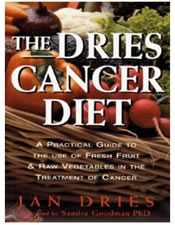Dries Cancer Diet
 The Dries Cancer Diet is the result of many years of research and clinical practice by nutritionist Jan Dries. When used as an adjunct to regular treatment it has produced remarkable results in hundreds of cancer patients.
The Dries Cancer Diet is the result of many years of research and clinical practice by nutritionist Jan Dries. When used as an adjunct to regular treatment it has produced remarkable results in hundreds of cancer patients.
Dries says that the diet is suitable for all cancer patients and can be used in conjunction with chemotherapy or radiation treatments. Upon recovery the continuation of the diet can also help to defend against a possible relapse.
Cancer Diet Basics
According to Dries the nutritional value, as well as the healing power of a specific food, is based on the amount of light energy, or its bio-energetic value. He says that cancer patients need to absorb as much energy as possible from their food so as to avoid depletion of their energy reserves. This can stimulate the self-healing mechanism of the body.
Although bio-energetic values may appear to be a novel way to gauge the quality of a food, Dries claims that several scientists, including the famous German physicist, Dr. Popp, have undertaken extensive research in this area. Dries claims to have expanded on the work of Dr. Popp by determining the different frequencies of foods that have a specific beneficial effect on improving immunity and resistance to cancer.
Raw foods are eaten exclusively for the first three months because they have the highest bio-energetic values. The diet is based predominantly on the consumption of raw fruits, especially tropical fruits such as pineapple and mango. Dries supports a high intake of fruit with scientific studies indicating that the consumption of 400 grams of fruit daily reduces the chance of cancer by 50%.
Certain raw vegetables, nuts and seeds are also included in the diet as well as dairy products, bee pollen, honey and some oils. Foods included that do not have a direct influence on the recovery process, but are not harmful either, include mayonnaise, vinaigrette dressing, and whipped cream. These are permitted because they help to improve the taste of meals as well as enhance digestion.
Recommended Foods
Pineapple is the most essential food in the Dries Cancer Diet. Other highly recommended foods include prickly pear, avocado, raspberry, honeydew melon, bee pollen, raw honey, bilberry, kiwi fruit, cherry, persimmon, apricot, mango, papaya, almonds, chervil, and mushrooms.
Sample Diet Plan
| On Getting Up
1-2 tablespoons bee pollen |
| Breakfast
½ pineapple |
| Morning Snack
½ pineapple blended into a smoothie |
| Lunch To start: Yogurt dip (50g yogurt mixed with fresh herbs) Main course: Mushroom Salad: |
| Afternoon Snack
½ orange |
| Dinner
150 g gooseberries |
| Evening Snack
40-50g comb honey |
Costs and Expenses
The Dries Cancer Diet retails at $12.95.
Pros
- Enables cancer patients to become actively involved in their recovery.
- May reduce the side effects of chemotherapy.
- Based on foods that are easy to digest.
- Does not require the use of nutritional supplements.
- Contains a high intake of vitamins, minerals and phytonutrients, many of which have been associated with a reduction in cancer occurrence.
- Does not have any side effects or dangers.
- Provides guidance for changing over to the diet gradually over a one-week period.
- Includes a seven-day meal plan and recipes.
- Acknowledges the role of psychological factors in cancer recovery.
Cons
- Very restrictive and some dieters may have difficulty following the diet as outlined.
- Requires a complete overhaul of the normal diet and may initially be disruptive to family meals and in social settings.
- May be some mild physical and/or emotional discomfort when first switching over to the diet.
- Optimal results will only occur if the diet is followed very strictly.
- Some dieters experience sensitivity to cold especially if the diet starts during autumn or winter.
- Not suitable for diabetic patients or those with anorexia or malnutrition.
Conclusions
Dries acknowledges the impossibility of predicting the outcome of cancer, while encouraging patients to follow the treatments that are advised by their doctors.
He does not make any promises but offers hope for cancer patients that is supported by hundreds of success stories.
-
Citations:
- Adelaiye, R. M., Miles, K. M., Ciamporcero, E., Nguyen, H., Vessella, R., Fontana, L., & Pili, R. (2013). Tumor growth inhibition and epigenetic changes following protein diet restriction in a human prostate cancer model. Cancer Research, 73(8 Supplement), 4859-4859. link
- Tokoro, A. (2013). Cancer and Diet. Encyclopedia of Behavioral Medicine, 283-284. link
i have used this diet when i completed my cancer treatment. for 3 months i was a vegan then slowly reintroduce regular meals with portion and choice modification. i will be a 10-year survivor on 20th january 2010.
DAIRY ACCELERATES cancer as proven by countless studies.. Stay away from the lactations of forein species if you have cancer or wish to avoid it. Milk is intented for that species young. They are of course DELICIOUS, but of no use to humans, and extremely harmful to endocrine systems, even though signs may not be seen for years. Although I do commend this diet’s vegetarian slant– it’s at least headed in the right direction.